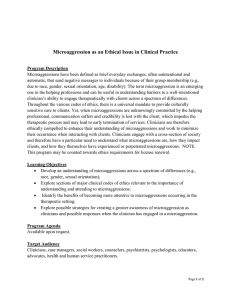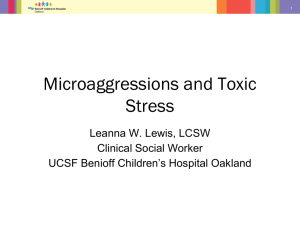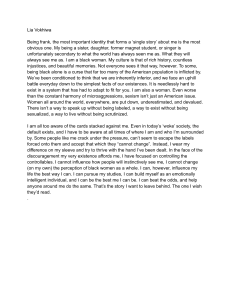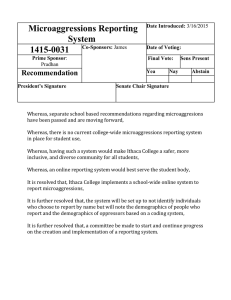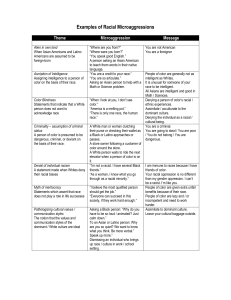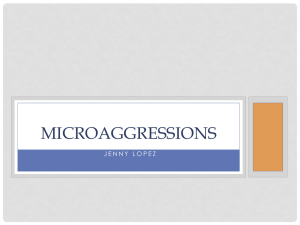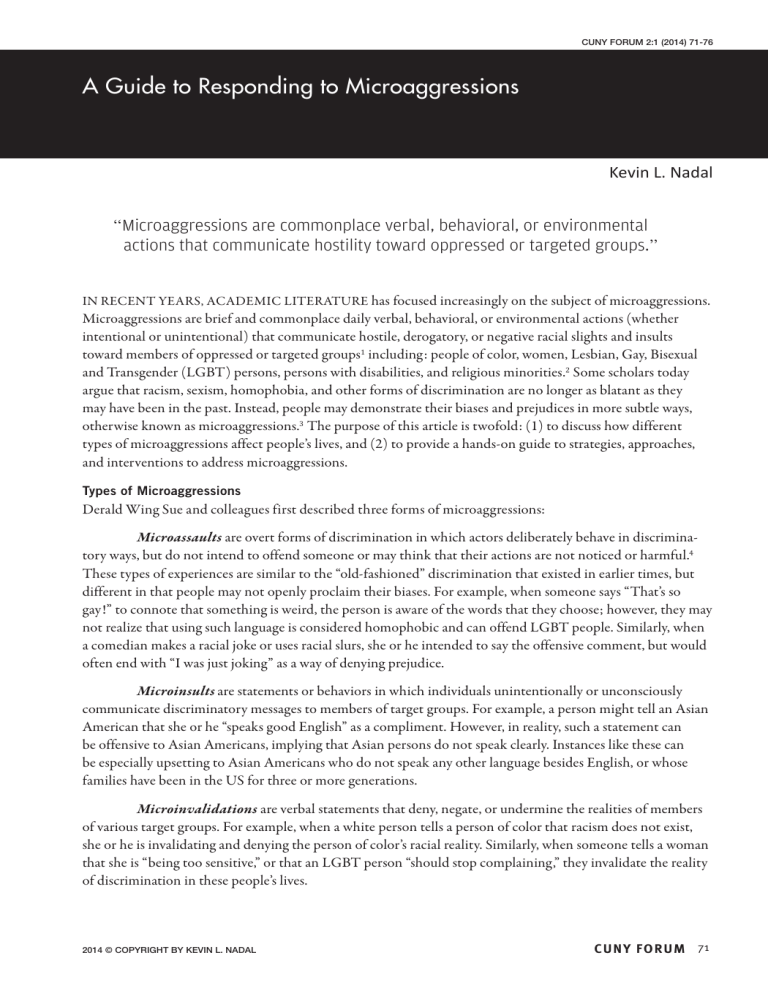
CUNY FORUM 2:1 (2014) 71-76 A Guide to Responding to Microaggressions Kevin L. Nadal “Microaggressions are commonplace verbal, behavioral, or environmental actions that communicate hostility toward oppressed or targeted groups.” IN RECENT YEARS, ACADEMIC LITERATURE has focused increasingly on the subject of microaggressions. Microaggressions are brief and commonplace daily verbal, behavioral, or environmental actions (whether intentional or unintentional) that communicate hostile, derogatory, or negative racial slights and insults toward members of oppressed or targeted groups1 including: people of color, women, Lesbian, Gay, Bisexual and Transgender (LGBT) persons, persons with disabilities, and religious minorities.2 Some scholars today argue that racism, sexism, homophobia, and other forms of discrimination are no longer as blatant as they may have been in the past. Instead, people may demonstrate their biases and prejudices in more subtle ways, otherwise known as microaggressions.3 The purpose of this article is twofold: (1) to discuss how different types of microaggressions affect people’s lives, and (2) to provide a hands-on guide to strategies, approaches, and interventions to address microaggressions. Types of Microaggressions Derald Wing Sue and colleagues first described three forms of microaggressions: Microassaults are overt forms of discrimination in which actors deliberately behave in discriminatory ways, but do not intend to offend someone or may think that their actions are not noticed or harmful.4 These types of experiences are similar to the “old-fashioned” discrimination that existed in earlier times, but different in that people may not openly proclaim their biases. For example, when someone says “That’s so gay!” to connote that something is weird, the person is aware of the words that they choose; however, they may not realize that using such language is considered homophobic and can offend LGBT people. Similarly, when a comedian makes a racial joke or uses racial slurs, she or he intended to say the offensive comment, but would often end with “I was just joking” as a way of denying prejudice. Microinsults are statements or behaviors in which individuals unintentionally or unconsciously communicate discriminatory messages to members of target groups. For example, a person might tell an Asian American that she or he “speaks good English” as a compliment. However, in reality, such a statement can be offensive to Asian Americans, implying that Asian persons do not speak clearly. Instances like these can be especially upsetting to Asian Americans who do not speak any other language besides English, or whose families have been in the US for three or more generations. Microinvalidations are verbal statements that deny, negate, or undermine the realities of members of various target groups. For example, when a white person tells a person of color that racism does not exist, she or he is invalidating and denying the person of color’s racial reality. Similarly, when someone tells a woman that she is “being too sensitive,” or that an LGBT person “should stop complaining,” they invalidate the reality of discrimination in these people’s lives. 2014 © COPYRIGHT BY KEVIN L. NADAL CUNY FORUM 71 Microaggressions Guide • Assumptions of Criminality (i.e., when people of color are assumed to be dangerous or deviant). For instance, if a clerk follows an African American around in a store, she or he is presuming that the person of color is going to steal.5 • Exoticization (i.e., when people of color are objectified or treated as tokens). A common occurrence is when a man tells an Asian American woman that she is so “exotic,” or that “he Racial has an Asian fetish.” • Assumptions of Intellectual Inferiority (i.e., when people of color are assumed to be less intelligent or capable than whites). An example is someone overemphasizing to a Latina that she is “so articulate” (subtly communicating that they did not expect her to be). • Pathologizing Cultural Values (i.e., when people of color are criticized for their communication styles, behaviors, styles of dress). For instance, when an Asian American or Latina/o is told to “get rid of your accent,” a subtle message is sent that one needs to assimilate.6 • Sexual Objectification (i.e., when a woman is treated as a sexual object). For instance, when a woman is catcalled on the street or a man attempts to look at a woman’s breasts, he is communicating that women’s bodies are allowed to be sexualized. • Assumptions of Traditional Gender Roles (i.e., when an individual assumes that a woman Gender needs to uphold traditional gender roles). For example, many women are told that they need to have a husband in order to be happy. • Assumptions of Inferiority (i.e., when a woman is assumed to be physically or intellectually incompetent, particularly in comparison to men). One illustration is when a woman is carrying a box and a man takes it away from her (without her permission), assuming she isn’t physically strong.7 • Use of heterosexist or transphobic terminology (i.e., when offensive language is used towards or about LGBT people). For instance, it is commonplace for young people to use the word “faggot” casually when describing someone as weak. • Discomfort/ Disapproval of LGBT experience (i.e., when LGBT individuals are treated with disrespect or condemnation because of their sexual orientation or gender presentation). One LGBT example includes a person staring at a same-sex couple holding hands, while another may be someone who makes prejudicial remarks about a transgender person. • Assumption of Sexual Pathology and Abnormality (i.e., when LGBT persons are presumed to be oversexualized or sexual deviants). One instance includes when someone presumes that all LGBT people may have HIV/AIDS, or stereotypes LGBT people as child molesters. • Endorsing religious stereotypes (i.e., when people make presumptions about religious minority groups). An example is when someone makes a joke about Muslim people being Religious terrorists or Jewish people being cheap.8 • Pathology of different religious groups (i.e., when someone judges another religion as being inferior or substandard). For instance, when someone treats a non-Christian as a second-class citizen.9 • Occurs as a result of an individual’s multiple groups and may influence the intensity or frequency of microaggressions. • Women of color may experience intersectional microaggressions, as a result of their gender Intersectional and race (e.g., a Latina who is denied service at a restaurant or store because of both her race and gender). • LGBT persons of color may experience intersectional microaggressions as a result of their sexual identity and race. For example, when a passersby ridicules a Black transgender woman, it can be due to her gender identity, her race, or both. 72 AAARI-CUNY How Do Microaggressions Affect People? While some people may believe that microaggressions are brief and harmless, many studies have found that microaggressions have a significant negative impact on people’s mental and physical health. For instance, a recent study has found that the more racial microaggressions that people of color experience, the more likely they are to also report depressive symptoms and a negative view of the world.10 In another study, LGBT participants reported that when they experienced microaggressions, they felt depressed, anxious, and even traumatized.11 Other researchers have found many other harmful effects of microaggressions. One study found that when college students experience microaggressions, they also binge drink or develop other alcohol-related issues.12 Two other studies found a relationship between microaggressions and intense psychological distress.13 How Can I Respond to Microaggressions? What are you supposed to do when you are the victim of a microaggression? In an article on racial microaggressions, Sue and colleagues discussed the “Catch 22” that people experience when they witness or are recipients of microaggressions.14 First, the individual may question if a microaggression has really occurred (i.e., “Did I hear him correctly when he made that comment?”). Next, the individual decides whether or not to take action. If the individual does respond, there is a likely outcome (e.g., arguments, defensiveness, denials, or additional microaggressions). If the individual does not respond, there is also an outcome (e.g., regret, resentment, sadness). Thus, the process of deciding how to respond to a microaggression can be stressful in itself. In my research, I describe a three-step process that assists an individual with how to react to a microaggression by asking him or herself the following:15 1. Did this microaggression really occur? 2. Should I respond to this microaggression? 3. How should I respond to this microaggression? Did this microaggression really occur? Sometimes microaggressions may be flagrantly obvious that a person can identify them effortlessly. For instance, when a man of color notices that a white woman clutches her purse as he enters an elevator, he may be able to identify this as a microaggression immediately. This has happened hundreds of times in his life and he is confident that she is assuming him to be a criminal. Similarly, when a person says “That's so gay!” in front of an LGBT person, the LGBT individual recognizes that the person is clearly using homophobic language. With some encounters, an individual may question whether a microaggression has happened. For example, if a woman hears someone whistle as she walks down a street, she may think, “Did that really just happen or am I hearing things?” Similarly, if a coworker makes a seemingly transphobic comment in front of a transgender female colleague, the recipient might question whether she heard the statement correctly. When there are people around (particularly people who the individual trusts) to verify and validate the microaggression, it makes it easier for the individual to definitively label the event as a microaggression. When there is no one around, it may be helpful to seek support from loved ones. For instance, with modern technology, people can easily call, text, email, or communicate with their social media networks about microaggressions. I myself have seen many people update their status on Facebook, describing microaggressions that happened to them on the subway or on the sidewalks. Most of the time, people respond in supportive ways. Should I respond to this microaggression? If an individual is certain (or moderately certain) that a microaggression did in fact occur, she or he has to ponder the potential risks or consequences of responding or not responding. Some questions include: CUNY FORUM 73 1. If I respond, could my physical safety be in danger? 2. If I respond, will the person become defensive and will this lead to an argument? 3. If I respond, how will this affect my relationship with this person (e.g., coworker, family member, etc.) 4. If I don’t respond, will I regret not saying something? 5. If I don't respond, does that convey that I accept the behavior or statement? How should I respond to this microaggression? If individuals do decide to take action, they must contemplate how to react. First, they can approach the situation in a passive-aggressive way. For instance, perhaps the victims make a joke or a sarcastic comment as a way of communicating that they are upset or annoyed. Perhaps the victims respond by rolling their eyes or sighing. Or, they do nothing in that moment and decide to talk to others about it first, in the hopes that it will get back to the perpetrator. Second, victims can react in a proactive way. This might be effective when the victim simply does not have the energy to engage the perpetrator in a discussion. Sometimes individuals who experience microaggressions regularly may feel so agitated that they just want to yell back. For some individuals, an active response may be a therapeutic way of releasing years of accumulated anger and frustration. Finally, an individual may act in an assertive way. This may include calmly addressing the perpetrator about how it made him or her feel. This may consist of educating the perpetrators, describing what was offensive about the microaggression. Oftentimes the perpetrator will become defensive, which may lead to further microaggressions (particularly microinvalidations). It may be important to use “I” statements (e.g., “I felt hurt when you said that.”), instead of attacking statements (e.g., “You’re a racist!”). It also may be important to address the behavior and not the perpetrator. What this means is that instead of calling the perpetrator “a racist,” it might be best to say that the behavior he or she engaged in was racially charged and offensive. People don’t like being called a racist, sexist or homophobe, so if you want to have an effective dialogue with a person without being defensive, it may be best to avoid using such language. When the entire interaction is over, it is important for the victim of the microaggression to seek support. Seeking support can include practical support (e.g., if someone experiences microaggressions at a workplace, she or he can file a complaint with Human Resources). Individuals can also seek social support (e.g., talking to your loved ones or peers with similar identities who can validate your experiences). Processing one’s emotions is also important because microaggressions have been known to lead to an array of mental health problems including depression, anxiety, and trauma.16 Therefore, individuals who experience microaggressions may find it helpful and necessary to discuss their cognitive and emotional reactions with their loved ones or mental health professionals. In doing so, individuals may avoid accumulating negative and detrimental feelings, which may affect their mental health. What If I Commit a Microaggression? First of all, everyone commits microaggressions. We have all done or said something that we may not have intended to offend someone, but somehow still ended up doing so. Sometimes we are aware of our actions, and other times it takes another person to point them out to you. If we were completely unaware that something we said or did was hurtful or offensive, there really isn’t anything we can do. However, when we are even slightly aware that we may have committed a microaggression or if we are confronted about it, there are several things that we can do. There may be moments when you think you may have committed a microaggression. Have you ever said or done something in which an individual winced or clearly reacted negatively? When someone’s behavior 74 AAARI-CUNY is noticeable, we might be able to detect that something we said or did may have caused it. If you are able to detect the potential cause, OWN UP TO IT! We need to admit when we commit microaggressions, learn from the wrongdoing, and apologize. We all make mistakes, consciously and not, and need to own up to them when we do. For moments in which someone confronts you on your behavior, listen to what he or she is trying to tell you and try not to be defensive. The worst thing that we can do is to deny that someone is hurt or offended by something we said or did. In fact, invalidating their experience could be considered a microaggression in itself. So again, admit to the wrongdoing and genuinely apologize. Furthermore, there are things that we can do to avoid microaggressions altogether. First, be aware of the language that you use. Common phrases like “That’s so gay!” often go under the radar because people do not realize that the language is actually homophobic and insulting. If something is weird, say it is weird! Why does it have to be called gay? Be aware of other subtle messages. For example, the color white is often used to convey that something is good (e.g., little white lie, white collar), while the color black is used to denote that something is bad (e.g., black sheep, blackmail, Black Friday). Finally, education about microaggressions is important. The more people are aware of the term and concept, the less likely they will be defensive when confronted about their behaviors. If we teach kids about diversity and equality from a very early age, we have the power to transform them into open-minded adults. Let us teach our kids to not be afraid, but rather to respect each other. Notes 1. Kevin Leo Nadal, “Preventing Racial, Ethnic, Gender, Sexual Minority, Disability, and Religious Microaggressions: Recommendations for Promoting Positive Mental Health,” Prevention in Counseling Psychology: Theory, Research, Practice and Training 2:1 (2008) 22-27. 2. Daniel Solorzano, Miguel Ceja, and Tara Yosso, “Critical Race Theory, Racial Microaggressions, and Campus Racial Climate: The Experiences of African American College Students,” Journal of Negro Education 69 (2000): 60 –73. 3. C. Pierce, J. Carew, D. Pierce-Gonzalez, and D. Willis. An Experiment in Racism: TV Commercial, C. Pierce, ed., Television And Education (Beverly Hills, CA: Sage, 1978): 62–88. 4. Derald Wing Sue, Jennifer M. Bucceri, Annie I. Lin, Kevin Leo Nadal, and Gina C. Torino, “Racial Microaggressions and the Asian American Experience,” Cultural Diversity and Ethnic Minority Psychology, 13:1 (2007): 72-81; Derald Wing Sue, Christina M. Capodilupo, Gina C. Torino, Jennifer M. Bucceri, Aisha M. Holder, Kevin Leo Nadal, and Marta Esquilin, “Racial Microaggressions In Everyday Life: Implications For Counseling,” The American Psychologist 62:4 (2007): 271-286. 5. Derald Wing Sue, Kevin Leo Nadal, Christina M. Capodilupo, Annie I. Lin, Gina C. Torino, and David P. Rivera, “Racial Microaggressions against Black Americans: Implications for counseling,” Journal of Counseling and Development, 86:3 (2008): 330-338. 6. David P. Rivera, Erin E. Forquer, and Rebecca Rangel. Microaggressions and the Life Experience of Latina/o Americans. D. W. Sue ed., Microaggressions and Marginality: Manifestation, Dynamics, and Impact (New York: Wiley & Sons, 2010): 59-84. 7. Christina M. Capodilupo, Kevin Leo Nadal, Lindsay Corman, Sahran Hamit, Oliver B. Lyons, and Alexa Weinberg, “The Manifestation of Gender Microaggressions,” Derald Wing Sue, ed. Microaggressions and Marginality: Manifestation, Dynamics, and Impact (New York: Wiley & Sons, 2010): 193-216; Kevin Leo Nadal, Marie-Anne Issa, Jayleen Leon, Vanessa Meterko, Michelle Wideman, and Yinglee Wong, “Sexual Orientation Microaggressions: Psychological Impacts on Lesbian, Gay, and Bisexual Youth,” Journal of LGBT Youth, 8:3 (2011); 8. Kevin Leo Nadal, Katie E. Griffin, Sahran Hamit, Jayleen Leon, Michael Tobio, and David P. Rivera, “Subtle and Overt Forms of Islamophobia: Microaggressions toward Muslim Americans,” Journal of Muslim Mental Health 6:2 (2012): 16-37. 9. Kevin Leo Nadal, That’s So Gay! Microaggressions and the Lesbian, Gay, Bisexual, and Transgender Community. Washington DC: American Psychological Association, 2013. 10. Kevin Leo Nadal, Katie E. Griffin, Yinglee Wong, Sahran Hamit, and Morgan Rasmus, “Racial Microaggressions and Mental Health: Counseling Clients of Color,” Journal of Counseling and Development 92:1 (2014): 57-66. CUNY FORUM 75 11. Kevin Leo Nadal, Yinglee Wong, Marie-Anne Issa, Vanessa Meterko, Jayleen Leon, and Michelle Wideman, “Sexual Orientation Microaggressions: Processes and Coping Mechanisms For Lesbian, Gay, and Bisexual Individuals,” Journal of LGBT Issues in Counseling, 5:1 (2011): 21-46. 12. Arthur W. Blume, Laura V. Lovato, Bryan N. Thyken, and Natasha Denny, “The Relationship of Microaggressions with Alcohol Use and Anxiety among Ethnic Minority College Students in a Historically White Institution,” Cultural Diversity and Ethnic Minority Psychology, 18:1 (2012): 45-54. 13. William A. Smith, Man Hung, and Jeremy D. Franklin, “Racial Battle Fatigue and the ‘Mis’Education of Black Men: Racial Microaggressions, Societal Problems, and Environmental Stress,” Journal of Negro Education, 80:1 (2011): 63-82; Jennifer Wang, Janxin Leu, and Yuichi Shoda, “When the Seemingly Innocuous ‘Stings’: Racial Microaggressions and Their Emotional Consequences,” Personality and Social Psychology Bulletin, 37:12 (2011): 1666-1678. 14. Derald Wing Sue, Christina M. Capodilupo, Gina C. Torino, Jennifer M. Bucceri, Aisha M. Holder, Kevin Leo Nadal, and Marta Esquilin, “Racial Microaggressions In Everyday Life: Implications For Counseling,” The American Psychologist 62:4 (2007): 271-286. 15. Kevin Leo Nadal, “Responding To Racial, Gender, and Sexual Orientation Microaggressions in The Workplace,” Mi- chele A. Paludi, Eros R. DeSouza & Carmen A. Paludi Jr., eds., The Praeger Handbook on Understanding and Preventing Workplace Discrimination: Legal, Management, and Social Science Perspectives (Santa Barbara, CA: Praeger, 2011). 16. Kevin Leo Nadal, That’s So Gay! Microaggressions and the Lesbian, Gay, Bisexual, and Transgender Community. Washing- ton DC: American Psychological Association, 2013. Author Kevin Nadal is an award-winning professor, psychologist, performer, activist, and author, who received his doctorate in counseling psychology from Columbia University in New York City. Currently, Dr. Nadal is an Associate Professor of psychology at John Jay College of Criminal Justice — City University of New York, where he is also the deputy director of the Forensic Mental Health Counseling Program. He is one of the leading researchers in understanding the impacts of microaggressions, or subtle forms of discrimination, on the mental and physical health of people of color, lesbian, gay, bisexual, and transgender (LGBT) people, and other marginalized groups. He has published over 50 works on multicultural issues in the fields of psychology and education. He is the author of the books Filipino American Psychology: A Handbook of Theory, Research, and Clinical Practice (2011, John Wiley and Sons) and Filipino American Psychology: A Collection of Personal Narratives (2010, Author House), a co-editor of Women and Mental Disorders (2011, Praeger), and the author of That's So Gay: Microaggressions and the Lesbian, Gay, Bisexual, and Transgender Community (2013, APA Books). 76 AAARI-CUNY
